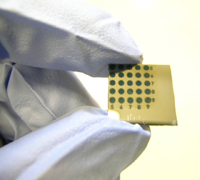|
Using the programmable “one-pot synthesis of oligosaccharides developed by Chi-Huey Wong, Director of Genomics Research Center at Academia Sinica, Taipei, a new method for the fabrication of carbohydrate microarrays (aka sugar chips) was reported by the Wong group in the last issue of the premier international journal Angewandte Chemie (Angew. Chem. Int. Ed. 2006, 45, 2753-2757)
This new breakthrough enables the rapid synthesis of oligosaccharides and attachment of them to glass slides through a photosensitive linker, so the arrays can be directly characterized by mass spectrometry.
Since the introduction of gene arrays (aka gene chips), the genomic research has been progressed rapidly and various genetic variations related to diseases have been identified. However, the result of gene array analysis may not be directly correlated with the function at the protein level. Understanding the relationship between genetic changes and disease states represents a new challenge, and functional genomics or proteomics has thus become an important subject for study.
A major challenge in proteomics is to understand the functional impact of post-translational modification and of which protein glycosylation represents the most complex post-translational event. More than 50% of human proteins are glycosylated; however, the role of carbohydrates play in glycoproteins is relatively unknown, due to the lack of tools for study. Development of carbohydrate microarrays would provide a new tool for the study of carbohydrate-protein interaction and for the identification of carbohydrate receptors or ligands associated with cancer or viral infection.
“In combination with the technology used in the semiconductor industry and the strengths of synthetic carbohydrate chemistry as well as mass spectrometry at Genomics Research Center, we plan to develop a new carbohydrate array system for the high-throughput functional analysis of glycoproteins and oligosaccharides” said Wong. The reported array technology has been transferred to a biotech company for development of carbohydrate microarrays. For information, please refer to: www3.interscience.wiley.com



